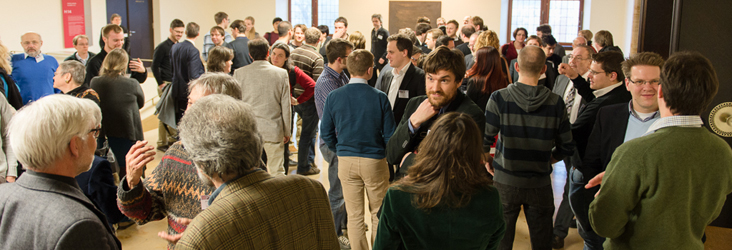
Events 2015
The Interdisciplinary Center for Scientific Computing (IWR) and its affiliated institutions organize a large number of events for discussing latest scientific results as well as identifing upcoming challenges in the field of Scientific Computing. In addition the IWR regularly hosts events which emphasis on broadening and improving the interdisciplinary dialogue.
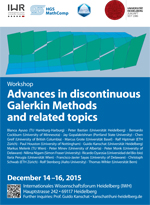
Workshop
"Advances in discontinuous Galerkin Methods and related topics"
December 14-16, 2015
For the recent decades, discontinuous Galerkin methods have seen a period of rapid growth in the development of their methodology and analysis. They are now established in a wide range of applications. This workshop convenes many of the long term leaders of the field and leading experts in applications of numerical methods. We will review the development, discuss the state of the art, and identify future directions of research with high potential. MATCH postdocs and students of HGS MathComp are invited to join the discussion, contribute and receive information directly from the experts.

10. Modellierungstag Rhein-Neckar
“Open Data“
3. Dezember 2015
Wir haben die Daten – nutzen wir sie!
Nach Public Domain und Open Source ist Open Data ein weiteres Buzzword, das den Zugang zu digitalen Ressourcen thematisiert. Public Domain ist die Idee, Programme kostenfrei zu vertreiben. Sie stammt aus der Urzeit der Programmierung. Viele hochwertige Anwendungen sind daraus entstanden. Open Source ist der nächste wichtige Meilenstein, denn erst die Freilegung des Quellcodes garantiert, dass Programme transparent werden und viele Entwickler freie Software stetig verbessern können. Mit Linux hat sich das heute erfolgreichste Server-Betriebssystem dieser Idee verschrieben. Open Data ist die logische Weiterentwicklung. Vor allem in Verwaltungsorganen, aber auch in öffentlich geförderten Forschungsprojekten oder in Krankenhäusern werden ständig große Datenmengen erzeugt. Diese Daten frei und umfassend zugänglich zu machen, ist die Idee hinter Open Data.
Dieses Konzept ist bestechend: Wenn die Allgemeinheit auf diese mit öffentlichem Geld geförderten Daten vollen Zugriff hat, kann auf vielfältige Weise ein gänzlich neuer Mehrwert entstehen. Aus diesem Ansatz ergeben sich Chancen und Risiken, die wir am Modellierungstag offen diskutieren wollen. Grundsätze bei der Publikation von Open Data Vorteile und Nachteile von Open Data für Unternehmen Qualitätssicherung in Open Data-Projekten Geschäftsmodelle auf Basis offener Daten
Zu diesen und weiteren Themen erwarten wir interessante Vorträge aus Wissenschaft und Wirtschaft. Auch die öffentliche Verwaltung ist zum Dialog rund um dieses Thema herzlich eingeladen, hängt doch Open Data eng mit Open Government, dem Konzept der offenen Beteiligung der Zivilgesellschaft an der Verwaltung, zusammen.
Der Modellierungstag Rhein-Neckar eröffnet Praktikern und Wissenschaftlern die Gelegenheit, Innovationen zur Diskussion zu stellen, Gemeinsamkeiten und Unterschiede der verwendeten Modellierungsansätze herauszuarbeiten und den gegenseitigen Erfahrungsaustausch zu pflegen.
Der Modellierungstag Rhein-Neckar kann durch Sie aktiv mitgestaltet werden: Durch aktuelle Beiträge aus Ihrer Arbeit. Forschungs- und Praxisbeiträge sind gleichermaßen willkommen. Die Veranstaltung wird von HGS MathComp, der InnovationLab GmbH und der BASF SE Ludwigshafen organisiert sowie von der IHK Rhein-Neckar und der Industrie unterstützt.
Die Teilnahme ist kostenfrei. Um Anmeldung unter www.modellierungstag.de wird gebeten.

IWR-Colloquium & HGS MathComp Romberg Inauguration Lecture
“Sparsity and inverse problems: a tale of splines and innovations“
Prof. Michael Unser, École polytechnique fédérale de Lausanne (EPFL), Lausanne, Switzerland
December 2, 2015
We start with a brief historical account of inverse problems in imaging. We highlight the emergence of the concept of sparsity, which opened the door to the resolution of more difficult image reconstruction problems, including compressed sensing. We then show the optimality of splines for solving problems with total-variation (TV) regularization constraints, which concludes the deterministic part of our story.
Next, we introduce a statistical formulation in which signals are modeled as sparse stochastic processes. These latter entities (including splines) are solutions of non-Gaussian stochastic differential equations and are intrinsically sparse in the sense that they admit a concise representation in a matched wavelet basis. The formalism is applied to the discretization of ill-conditioned linear inverse problems where both the statistical and physical measurement models are projected onto a linear reconstruction space. This leads to the specification of a general class of maximum a posteriori (MAP) signal estimators complemented with a practical iterative reconstruction scheme. While the framework is backward compatible with the traditional methods of Tikhonov and TV, it opens the door to a much broader class of potential functions that are inherently sparse, while it also suggests alternative Bayesian recovery procedures. The approach is illustrated with the reconstruction of images in a variety of modalities including deconvolution microscopy, phase-contrast tomography, and refractive-index microscopy.
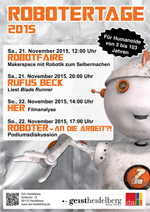
Heidelberger RobotFaire im DAI
21. November 2015
Am 21.11.2015 findet der Heidelberger RobotFaire im Deutsch-Amerikanisches Institut (DAI) statt. Das IWR-Robotiklabor und die Forschungsgruppe ORB an der Universität Heidelberg bieten zu diesem Anlass ein spannendes Programm für Jung und Alt an.
Neben Workshops und Vorträgen werden zahlreiche Exponate einen faszinierende Einblick in die Welt der Robotik ermöglichen. Studenten und Wissenschaftler zeigen dazu ihre aktuellen Projekte - von Roboterschlangen und Turtlebots über krabbelnden Hexapods bis hin zu einem Augmented-Reality-Sandkasten. Alle Exponate laden zum Mitmachen und Experimentieren ein um spielerisch die Welt der Robotik zu entdecken. Zusätzlich können Kinder und Jugendliche in einem gemeinsam Workshop mit dem DAI einen tanzenden Malroboter basteln.
Weitere Einblicke wird die Leiterin des Robotiklabors und der Forschungsgruppe ORB, Frau Prof. Katja Mombaur, am Samstagnachmittag geben. In ihrem Vortrag "Roboter: Mythos vs. Realität" wird sie bekannte Roboter aus Film und Fernsehen mit dem aktuellen Stand der Forschung vergleichen.
Der Eintritt ist kostenlos.
Heidelberger RobotFaire
Samstag, 21. November 2015, 12:00 Uhr
DAI Heidelberg
Sofienstr. 12
69115 Heidelberg
Weitere Informationen zum Programm des RobotFaire: dai-heidelberg.de/de/veranstaltungen/robotfaire-12186/
Website Forschungsgruppe ORB: www.iwr.uni-heidelberg.de/groups/orb
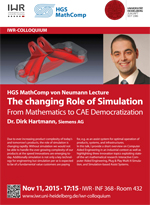
IWR-Colloquium & HGS MathComp von Neumann Lecture
“The changing Role of Simulation - From Mathematics to CAE Democratization“
Dr. Dirk Hartmann, Siemens AG
November 11, 2015
Due to ever increasing product complexity of today's and tomorrow’s products, the role of simulation is changing rapidly. Without simulation we would not be able to handle the ever growing complexity of our products at the speed innovations are emerging today. Additionally simulation is not only a key technology for engineering but simulation per se is expected to be of a fundamental value customers are paying for, e.g. as an assist system for optimal operation of products, systems, and infrastructures.
In this talk, I provide a short overview on Computer Aided Engineering in an industrial context as well as highlighting three innovation topics exploiting state-of-the-art mathematical research: Interactive Computer Aided Engineering, Plug & Play Multi-X-Simulation, and Simulation-based Assist Systems.
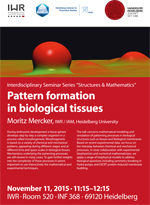
Interdisciplinary Seminar Series "Structures & Mathematics”
Pattern formation in biological tissues
Dr. Moritz Mercker, IWR / IAM, Heidelberg University
November 11, 2015
During embryonic development a tissue sphere develops step by step a complex organism in a process called morphogenesis. Morphogenesis is based on a variety of chemical and mechanical patterns, appearing during different stages and at different time and space scales in biological tissues. Mechanisms underlying the patterning processes are still elusive in many cases. To gain further insights into the complexity of these processes it seems important to use interactively the mathematical and experimental techniques.
The talk concerns mathematical modeling and simulation of patterning processes in biological structures such as tissues and biological membranes. Based on recent experimental data, we focus on the interplay between chemical and mechanical processes. In close collaboration with experimental biophysicists and numerical mathematicians, we apply a range of biophysical models to address biological questions including symmetry breaking in Hydra polyps and ESCRT protein-induced membrane budding.
11:15 • IWR • Room 520 • Im Neuenheimer Feld 368 • 69120 Heidelberg
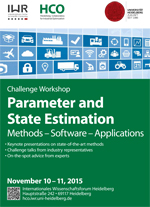
HCO Challenge Workshop
"Parameter and State Estimation: Methods - Software - Applications"
November 10-11, 2015
Model-based simulation and optimization methods become increasingly important for the development of new products and more efficient processes. However, successful application of model-based methods demands for the development of predictive mathematical models and their quantitative validation. This complex task requires robust and efficient numerical methods for parameter estimation. Furthermore, advanced control of processes in real time needs fast and reliable numerical methods for state estimation.
Industrial practice shows that in order to realize the full potential of modelling complex processes we have to deal with a number of new challenges. Because of the high relevance of parameter and state estimation methods for current and future research and development, the Heidelberg Collaboratory for industrial Optimization (HCO) invites decision makers, researchers and practitioners from academia and industry to participate in this workshop.
Primary goals are:
- present an overview of state-of-the-art methods for parameter and state estimation
- discuss current challenges in industry and academia
- identify requirements for the next generation of parameter and state estimation methods and software
- foster synergies and collaborations
This is the second workshop in a series on techniques for model-based optimization.
Application areas include (but are not limited to):
- Automotive Industry, Biology, Biomedical Engineering, Chemical Engineering, Econometrics, Energy Systems, Geomatics and Navigation, Pharmacokinetics, Robotics
Please register here.
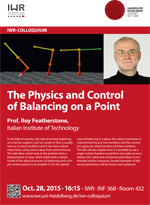
IWR-Colloquium
“The Physics and Control of Balancing on a Point“
Prof. Roy Featherstone, Italian Institute of Technology
October 28, 2015
In the field of robotics, the task of actively balancing on a narrow support, such as a point or line, is usually seen as a control problem; and it has been solved many times using various ideas from control theory. This talk takes a fresh look at the problem from a physical point of view, which yields both a simple model of the physical process of balancing and a simple control system to accomplish it. For the special case of balancing in a plane, the robot’s behaviour is characterized by just two numbers, and the controller’s gains are trivial functions of these numbers. The talk will also explain how it is possible to use a single motion freedom to perform two tasks at once: balance the robot and simultaneously follow a commanded motion trajectory. Several examples of balancing behaviours will be shown and explained.

ZUK 5.4 Workshop
"Gerichtssaal der Zukunft"
22.-23. Oktober 2015
Rechnergestützte Methoden gewinnen vor Gericht zunehmend an Bedeutung, da sie eine Objektive und nachvollziehbare Beweisführung ermöglichen. Diese beginnt mit der Dokumentation von Unfallorten, Tatorten und betroffenen Personen. Dabei werden verstärkt Systeme eingesetzt, die unterschiedlichste 3D-Messdaten liefern. Vor allem in verwandten forensisch arbeitenden Bereichen, wie z.B der Archäologie oder der GeoInformatik werden solche Verfahren erprobt und Methoden zur Auswertung entwickelt.
In diesem Interdisziplinären Umfeld werden Implikationen für die Exekutive und Judikative erörtert, damit die neuen Verfahren in deren täglicher Arbeit angewandt werden können. Dieser Workshop dient daher zur Vernetzung zwischen Informatik und Rechtsmedizin mit dem Ziel neue Techniken und Methoden für die Fragestellungen im Gerichtssaal des 21. Jahrhundert zu erarbeiten.
Der Workshop behandelt die folgenden Themenbereiche:
- Methoden zur Tatortrekonstruktion, Unfallanalyse und Verletzungsdokumentation
- Technologien für mikroskopische Spuren in 3D bis hin zu GeoInformationsSystemen
- Interdisziplinäre Verbindung von Rechtsmedizin, Informatik, Exekutive und Judikative
- Visualisierungen und Messdaten in neuem Kontext – wie bildgebende Verfahren den Alltag im Gerichtssaal verändern
- Juristische Voraussetzungen für die künftige Anwendung in der Praxis
Für die kostenlose Teilnahme am Workshop “Gerichtssaal der Zukunft” ist eine verbindliche Registrierung bis zum 15. Oktober 2015 notwendig.
Link: Online-Registierung
Workshop
"Probabilistic Graphical Models"
October 22-23, 2015
Probabilistic graphical models provide a consistent framework for the statistical modeling and the computational analysis of scientific empirical data. The past decade has witnessed a significant increase in respective research in the field of image analysis and related application areas, driven by the synergy between statistics, pattern recognition, computer vision and machine learning. The objective is to devise models that enable to infer a coherent global interpretation of noisy and ambiguous local image measurements, taking into account spatiotemporal context in images and videos, and domain-specific contextual knowledge.
Applications of probabilistic graphical models to such large-scale problems raise numerous research problems of modeling and algorithm design for inference and learning, requiring interdisciplinary expertise in applied mathematics, computer science and physics, besides a profound knowledge of the respective application areas.
Confirmed speakers:
- Mario A. T. Figueiredo, Instituto Superior Técnico, Portugal
- Victor Lempitsky, Skoltech Computer Vision, Russia
- Raquel Urtasun, University of Toronto, Canada
- Max Welling, University of Amsterdam, Netherlands
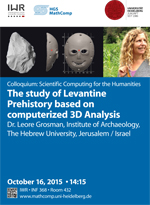
Colloquium: Scientific Computing for the Humanities
"The study of Levantine Prehistory based on computerized 3D Analysis - Colloquium: Scientific Computing for the Humanities"
Dr. Leore Grosman, Institute of Archaeology, The Hebrew University, Jerusalem / Israel
October 16, 2015
Archaeology Laboratory at the Hebrew University integrates techniques and ideas from computer science (e.g., computer graphics, machine learning) in the archaeological research methodologies. We operate optical scanners which provide three dimensional (3D) digital models that are analyzed with computer programs developed in our laboratory. We address research issues and needs which could not be addressed without the availability of digital 3D models. Beyond ‘capturing’ and visualizing data, I will focus on the process of analysis and provide novel ways of interpretation. Several examples will be presented as the clustering between prehistoric lithic assemblages while verifying or negating the traditional classification. This will provide new insights to the path of Homo Erectus out of Africa c.a. 1.4 million years ago and the Neanderthal occupation in the Southern Levant c.a. 100,000 years ago.

7th KoMSO Challenge Workshop
"Mathematical Modeling, Simulation and Optimization for Energy Conservation"
October 8-9, 2015
Energy efficiency remains the second pillar of the Energiewende. In keeping with its energy concept, it is the German government’s long-term objective to reduce energy consumption by 50 percent until 2050 compared to the respective figures in 2008.
It is the goal of this workshop to evaluate the potential of mathematical modeling, simulation and optimization (MSO) for energy conservation in industrial systems and processes and to identify new relevant MSO methods in this respect.
Practical aim of this workshop is to lay the content-related groundwork for a call for proposals, e.g. with the Federal Ministry of Education and Research (BMBF) or the Federal Ministry of Economics and Technology (BMWi).
Furthermore, this event serves as platform for industrial and academic exchange regarding the complex issue of mathematical MSO for energy conservation.
We kindly invite your contribution and participation. Note that the number of participants is limited. Please register for free at www.komso.org.
Workshop
"Traffic Optimization"
October 8, 2015
Traffic optimization is a big field related to many subjects, such as, mathematics, computer science, or physic. In big cities, people are suffering from traffic problems, for example traffic jams, traffic accidents. Thus, improving traffic systems in urban areas becomes more and more important. The 1-day workshop on "Traffic Optimization" is organized by the research group for Discrete and Combinatorial Optimization on 8th October, 2015. The workshop aims at addressing the many aspects of traffic optimization, in particular in urban environments. The main purpose is to introduce the field to general audience. There are about 6-8 experts coming from Germany, Italy, Hungary, and Spain. Each one will give a 45-minutes talk about some topics as followings:
- Routing problems, such as shortest path, dissimilar paths, etc.
- Traffic assignment modeling
- Traffic simulation
59. Heidelberger Bildverarbeitungsforum
"Mobile Bildverarbeitung"
6. Oktober 2015
In den letzten Jahren hat sich die Rechenleistung mobiler Geräte im Verhältnis zum Energieverbrauch so weit gesteigert, dass selbst komplexere Bildverarbeitungsaufgaben damit bewältigt werden können. Das wird mittelfristig zu einer Verschiebung der eingesetzten Plattformen und allen Anwendungsbereichen führen und gleichzeitig viele neue Bereiche außerhalb der klassischen Anwendungen der Bildverarbeitung in der industriellen Produktion erschließen. Diese Entwicklung ist auch im Zusammenhang mit Industrie 4.0 und dem Internet der Dinge (IoT, internet of things) zu sehen.
Das 59. Heidelberger Bildverarbeitungsforum mit dem Schwerpunktthema Mobile Bildverarbeitung bereitet diese Fragestellungen systematisch auf. Die Vorträge werden viele Applikationen auf Consumerplattformen wie dem Smartphone vorstellen, die neuesten Entwicklungen im Bereich energieeffizienter heterogener Rechnerarchitekturen beleuchten und Algorithmen zur Umgebungsmodellierung für mobile Bildverarbeitungs-plattformen präsentieren. Auch wird ein Blick über den Tellerrand der Bildverarbeitung geworfen und der Status und die Zukunftsperspektiven des mobilen Computings werden dargestellt.
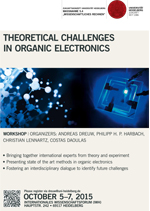
ZUK 5.4 Workshop
"Theoretical Challenges in Organic Electronics"
October 5-7, 2015
- Bringing together international experts from theory and experiment
- Presenting state of the art methods in organic electronics
- Fostering an interdisciplinary dialogue to identify future challenges
Compact Course / Summer School
"Computing Art. A summer school for digital art history"
September 30 - October 2, 2015
The summer school for digital art history is organized by the Computer Vision Group Heidelberg of the Interdisciplinary Center for Scientific Computing (IWR), the HGS Math Comp, the Heidelberg Academy of Science and Humanities, and the research group digital art history.
Digital art history is considered to be part of the discipline of art history as well as part of digital humanities as digitally based methods require an interdisciplinary approach. In short, this means using digital infrastructures and tools, but also critically reflecting upon their usage and understanding the technical background (quoted from “Memorandum zur digitalen Kunstgeschichte in der Lehre” (memorandum on digital art history in education)). Digital art history is not only faced with the challenge of analysing objects as primarily art historical research subjects not only in the context of increasingly mimetic digital representations, but also of embedding these representations in the semantic and stylistic contexts of the artwork. In order to succeed in these challenges, immediate access to the visual information of the digital representation, as well as access to virtual research environments which will help to depict semantic relations, is required.
Starting with the digital representation of the artwork, the summer school for digital art history demonstrates ways of processing the artwork visually, iconographically and contextually. The focus is on new methods of annotation and image analysis. Up until now nearly all steps of digital image exploitation were left up to various experts: content processing was the task of student assistants and often highly qualified art historians whereas the creation of new digital records only concerned IT specialists or ambitious self-educated scholars. New exploitation strategies, such as crowd sourcing, machine learning and computer vision, provide the specialist with algorithms/artificial intelligence and laypersons that enable effective mass processing of image data. In addition, new collaborations and interdisciplinary links are forming between the classical scientific fields. The digital image is not only described, but also analysed in terms of content and compared with others. These processes must be developed and critically monitored.
Bernstein Conference 2015
September 14-17, 2015
The Bernstein Conference is the Bernstein Network's central forum that has developed over time into the largest annual Computational Neuroscience conference in Europe, attracting an international audience from across the world. It is organized by members of the Bernstein Network at annually changing locations and offers a broad overview over the topics of Computational Neuroscience and Neurotechnology. The 2015 conference will take place in Heidelberg.
- Satellite Workshops: September 14, 2015
- Main Conference: September 15-17, 2015
- PhD Symposium: September 17-18, 2015
Please register here.

ZUK 5.4 Workshop
"Scientific Computing in the Behavioral Sciences -
SCBS 2015"
July 27-29, 2015
The workshop will provide a meeting ground for applied mathematicians, psychologists and other behavioral scientists interested in exploring computational modeling in the behavioral sciences. One focus of the workshop will be dynamic decision making, complex problem solving, as well as issues of optimal experimental design. Computational modeling and simulation of human cognition is an emergent multidisciplinary field of research promising breakthroughs for both basic research and applications. There is already a wide range of notable examples illustrating the successful application of scientific computing to cognitive models from working memory to intelligent tutoring systems.
Mathematical methods and computational tools for process modeling, which have a long success story in other disciplines, e.g. chemical engineering, may help to address the challenges and potential pitfalls arising in this approach. A successful implementation, however, requires a broad range of skills and knowledge.
Therefore, in this workshop, we bring together experts from the different fields of cognitive modeling and process modeling. We will discuss the available methodological approaches and tools as well as their limitations in order to foster effective future collaborations. A methodological focus will be on effective parameter estimation methods, model validation procedures, model-based optimum experimental design, and the application of these methods to models of cognition.
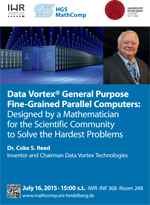
HGS MathComp Talk
"Data Vortex General Purpose Fine-Grained Parallel Computers: Designed by a Mathematician for the Scientific Community to Solve the Hardest Problems"
Dr. Coke S. Reed, Data Vortex Technologies
July 16, 2015
"The Data Vortex network enables scientists to perform work on problems that rely on a tremendous flood of processor-to-processor communication, something that present-day computers handle quite poorly. For example, the Data Vortex is used to perform the FFT algorithm. In 1805, Karl Friedrich Gauss used the Fast Fourier Transform to determine the trajectories of the comets Pallas and Juno. It is of note that the original manuscript of Fourier on the subject of Fourier analyses appeared in 1807. The Gauss work describes the data flow of the transform. It is of interest that the Data Vortex computer enables this FFT data flow on a general purpose computer for the first time. This topic of FFT data flow as well as the general topic of data flow algorithms on Data Vortex computers will also be discussed.
Dr. Reeds talk will be followed by a brief overview of the Data Vortex family of high performance computers currently being manufactured by Plexus, Inc. This overview, given by Mr. Bill Stube, Data Vortex Project Manager for Plexus, Inc., will include a high-level description of the Data Vortex enabled system characteristics, performance comparisons to present-day leading supercomputer systems, and an overview of the simple programming model used by Data Vortex researchers to port their work onto Data Vortex computers."
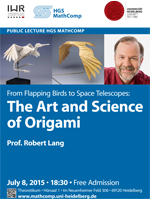
HGS MathComp Public Lecture
“From Flapping Birds to Space Telescopes: The Art and Science of Origami“
Prof. Robert Lang, Alamo, California, USA
July 8, 2015
The last decade of this past century has been witness to a revolution in the development and application of mathematical techniques to origami, the centuries-old Japanese art of paper-folding. The techniques used in mathematical origami design range from the abstruse to the highly approachable. In this talk, I will describe how geometric concepts led to the solution of a broad class of origami folding problems specifically, the problem of efficiently folding a shape with an arbitrary number and arrangement of flaps, and along the way, enabled origami designs of mind-blowing complexity and realism, some of which youll see, too. As often happens in mathematics, theory originally developed for its own sake has led to some surprising practical applications. The algorithms and theorems of origami design have shed light on long-standing mathematical questions and have solved practical engineering problems. I will discuss examples of how origami has enabled safer airbags, Brobdingnagian space telescopes, and more.
Robert J. Lang is recognized as one of the foremost origami artists in the world as well as a pioneer in computational origami and the development of formal design algorithms for folding. With a Ph.D. in Applied Physics from Caltech, he has, during the course of work at NASA/Jet Propulsion Laboratory, Spectra Diode Laboratories, and JDS Uniphase, authored or co-authored over 100 papers and 50 patents in lasers and optoelectronics as well as authoring, co-authoring, or editing 14 books and a CD-ROM on origami. He is a full-time artist and consultant on origami and its applications to engineering problems but keeps his toes in the world of lasers, most recently as the Editor-in-Chief of the IEEE Journal of Quantum Electronics from 2007-2010. He received Caltechs highest honor, the Distinguished Alumni Award, in 2009 and was elected a Fellow of the American Mathematical Society in 2013.
Website Prof. R. Lang: www.langorigami.com
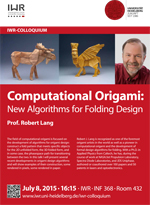
IWR-Colloquium
“Computational Origami: New Algorithms for Folding Design"
Robert J. Lang, Alamo, California, USA
July 8, 2015
The field of computational origami is focused on the development of algorithms for origami design: construct a fold pattern that meets specific objects for the 2D unfolded form, the 3D folded form, and in some case, the phasespace path for transitioning between the two. In this talk I will present several recent developments in origami design algorithms and will show examples of their construction, some rendered in pixels, some rendered in paper.
Robert J. Lang is recognized as one of the foremost origami artists in the world as well as a pioneer in computational origami and the development of formal design algorithms for folding. With a Ph.D. in Applied Physics from Caltech, he has, during the course of work at NASA/Jet Propulsion Laboratory, Spectra Diode Laboratories, and JDS Uniphase, authored or coauthored over 100 papers and 50 patents in lasers and optoelectronics as well as authoring, coauthoring, or editing 14 books and a CDROM on origami. He is a fulltime artist and consultant on origami and its applications to engineering problems but keeps his toes in the world of lasers, most recently as the EditorinChief of the IEEE Journal of Quantum Electronics from 2007–2010. He received Caltech’s highest honor, the Distinguished Alumni Award, in 2009 and was elected a Fellow of the American Mathematical Society in 2013.
Website Prof. R. Lang: www.langorigami.com
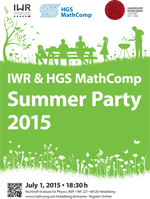
IWR & HGS MathComp Summer Party
July 1, 2015
We kindly invite all members, students and staff of the IWR and the HGS MathComp to join us at our 2015 summer party.
As usual, in accordance with university guidelines, we have to charge 10,- EUR per person to cover expenses - children attend free of charge.
Please make sure to register online for the event.
Link: Online Registration
(Registration Deadline: June 26, 2015)

IWR-Colloquium
"Darcy Lecture: Numerical Models for Evaluating the Competitive Use of the Subsurface - The Influence of Energy Storage and Production in Groundwater"
Prof. Rainer Helmig, University of Stuttgart, 2015 Darcy Lecturer
July 1, 2015
Gain insight on how advanced numerical models may be used to analyze and predict the mutual influence of subsurface projects and their impact on groundwater reservoirs, and the increasing need to do so, during this presentation.
While historically there have been few issues of concern related to competition between resources, with groundwater contamination being an exception, the subsurface is being increasingly utilized both as a resource, and as an energy and waste repository. With increasing exploitation, resource conflicts are becoming increasingly common and complex such as the long-range impact of mechanical, chemical, and thermal energy storage on groundwater resources, and the effects surrounding hydraulic fracturing in both geothermal and shale gas production.
In general, subsurface systems include processes of varying complexity occurring in different parts of the domain of interest. These processes mostly take place on different spatial and temporal scales making it extremely challenging to model such systems in an adequate way. During this lecture you will learn about:
- Possible utilization conflicts in subsurface systems and how the groundwater is affected
- Model coupling concepts with a focus on the author’s work in this field; the concepts are divided into temporal and spatial coupling concepts, where the latter are subdivided into multiprocess, multiscale, multidimensional, and multicompartment coupling strategies
- Fundamental properties and functions of a compositional multiphase system in a porous medium; basic multiscale and multiphysics concepts will be introduced and conservation laws formulated
- Numerical solution procedures for both decoupled and coupled model formulations; two applications of multiphysics and multiscale algorithms will be presented and discussed
- Large-scale simulation that shows the general applicability of the modeling concepts of such complicated natural systems, especially the impact on the groundwater of simultaneously using geothermal energy and storing chemical and thermal energy, and how such real large-scale systems provide a good environment for balancing the efficiency potential and possible weaknesses of the approaches discussed.
This lecture is part of the Darcy Lecture Series in Groundwater Science.
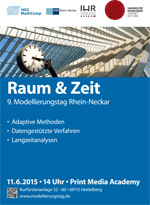
9. Modellierungstag Rhein-Neckar „Raum & Zeit“
June 11, 2015
Der 9. Modellierungstag widmet sich Fragestellungen rund um das Thema „Raum & Zeit“ und eröffnet eine Vielzahl von Diskussionsmöglichkeiten mit den Fachvertretern.
In Impulsvorträgen beleuchten wir die Problematik von unterschiedlichen Seiten und zeigen auf, mit welchen Mitteln das Wissenschaftliche Rechnen Antworten auf komplexe Fragestellungen zur Modellierung und Simulation findet. Das Spektrum der eingesetzten Verfahren reicht dabei von inhomogenen Raumgittern und variablen Zeitschrittverfahren bis hin zur statistischen Langzeitanalyse von Simulationskomponenten.
Der Modellierungstag eröffnet als Plattform die Möglichkeit, die Kommunikation zwischen Industrie und Universität zu diesem umfassenden Thema auszudehnen.
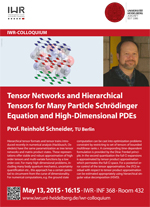
IWR-Colloquium
"Tensor networks and hierarchical tensors for many particle Schrödinger equation and high-dimensional PDEs"
Prof. Reinhold Schneider, TU Berlin
May 13, 2015
Hierarchical tensor formats and tensor trains introduced recently in numerical analysis (Hackbusch, Oseledets) have the same parametrization as tree tensor networks and matrix product states. These representations offer stable and robust approximation of high order tensors and multi-variate functions by a low order cost. For many high dimensional problems, including many body quantum mechanics, uncertainty quantification etc., this approach has a certain potential to circumvent from the curse of dimensionality. For numerical computations, e.g. the ground state computation can be cast into optimization problems constraint by restricting to set of tensors of bounded multilinear ranks r. A corresponding time-dependent formulation is provided by the Dirac Frenkel principle. In the second quantization the full CI expansions is approximated by tensor product approximation which permeates the full CI space. For a posteriori error control of the tensor approximation, the (FCI) residual with respect to tensor product approximation can be estimated appropriately using hierarchical singular value decomposition (HSVD).
HPSC Hanoi 2015 - 6th International Conference on Modeling, Simulation and Optimization of Complex Processes
March 16-20, 2015 — Hanoi, Vietnam
EU-SEA Workshop Advanced Computing for Control and Performance Optimization: Algorithms and Applications
March 9-10, 2015 - Pattaya, Chonburi, Thailand
Participants will obtain first-hand information about the latest research in dynamic optimization and advanced control in Europe, including industrial applications. The academic participants from Europe and SEA will learn about current problems in industry in Europe and SEA, and potential bottlenecks for the application of advanced optimization-based methods.
The workshop will create a basis for further collaborations in cyber-physical systems, industrial automation and advanced computing. Participants from SEA countries and from Europe will learn about the current research and development in both regions, get to know each other and develop a joint understanding for the needs of industry, especially under SEA's economical and structural conditions. The workshop will stimulate research and development collaborations with industrial and academic partners, including joint project proposals, and other follow up activities. Information about related funding and collaboration opportunities offered by the European Union and about how to benefit from them will be given.
Workshop "Women in Optimization"
March 2-4, 2015
The workshop targets female junior researchers, PhD students and students of Mathematics with a focus on optimization. The goal of the workshop is to provide advanced scientific training in the field of optimization as well as an opportunity for networking in the optimization community. By lectures of invited speakers working in all areas of optimization in academia and industry we want to present on the one hand a wide scientific spectrum of topics in mathematical optimization as well as different possible career models in this field. In addition to these lectures there will be ample opportunities for discussions and an exchange of experiences. All participants are invited to actively participate in poster presentations.
DUNE/PDELab Course
February 23-27, 2015
This one week course will provide an introduction to the most important DUNE modules and especially to DUNE-PDELab. At the end the attendees will have a solid knowledge of the simulation workflow from mesh generation and implementation of finite element and finite volume methods to visualization of the results. Topics covered are the solution of stationary and time-dependent problems, as well as local adaptivity, the use of parallel computers and the solution of non-linear PDE's and systems of PDE's.
MCBR4 - 4th Indo-German Winter School and Meeting on Modeling of Chemical and Biological Reactivity
February 17-25, 2015
Computer-based models of chemical reaction processes – particularly within biological systems – are the central focus of the one-week gathering of scientists at the University of Heidelberg, addressed to scientists from Germany, India and Japan. 20 PhD students from Germany and India will join in the “Winter School on Modeling of Chemical and Biological Reactivity“ (MCBR) on February 17-22, 2015. On February 23-25, this is followed by the fourth MCBR-meeting with scientists from Germany and India and, for the first time, with colleagues from Japan. Building a German-Indian-Japanese network, this meeting will gather more than 20 scientists plus the PhD students from the winter school. Both events will be hosted by the Institute of Inorganic Chemistry and the Interdisciplinary Center for Scientific Computing (IWR) at the University of Heidelberg.
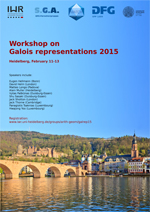
Workshop on Galois Representations
February 11-13, 2015
Some main themes of the workshop are the local structure of Galois representations at p and patching. In addition there will be several talks on global results and on congruences. The meeting will be take place at the Interdisciplinary Center for Scientific Computing (IWR).
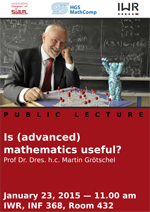
SIAM Heidelberg Chapter Public Lecture
"Is (advanced) mathematics useful?"
Prof. Martin Grötschel, Konrad-Zuse-Zentrum für Informationstechnik Berlin (ZIB)
January 23, 2015
The Siam Chapter of Heidelberg is glad to announce the talk "Is (advanced) mathematics useful? — Ist (höhere) Mathematik nützlich?" by Prof. Martin Grötschel from Technische Universität Berlin and Zuse Institut Berlin. The speaker Prof. Grötschel is an outstanding expert in combinatorial optimization. He made seminal contributions to the Traveling Salesman Problem, cutting plane methods in mixed-integer linear optimization and graph theory.